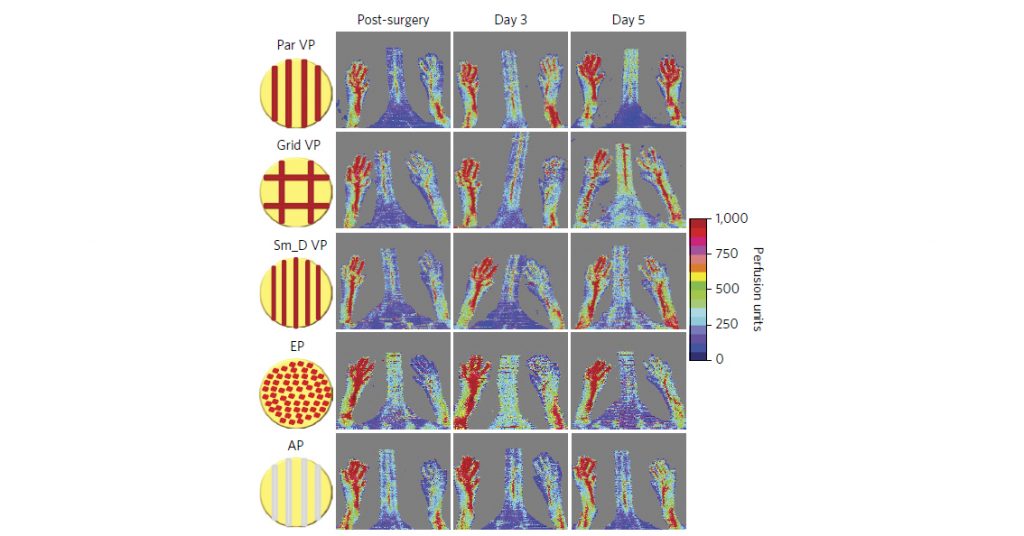Left without a trellis, vines will grow in any direction toward the sun. Much like climbing plants, new blood vessels need a guide too. In regenerative medicine research funded by the National Institute of Biomedical Imaging and Bioengineering (NIBIB) 3D printed scaffolds have proved a useful tool for helping to grow small blood vessels.
The 3D-printed vascular networks are undergoing study for their potential to treat ischemia – a medical condition responsible for restricting blood flow to parts of the body.
At its most effective, the regenerative blood vessel treatment is capable of encouraging the regrowth of 70% of the vessels in the ischemic foot of a mouse model.
The global burden of disease
Ischemia can occur in the heart, the brain, bowel, limbs and the skin. If left untreated, the condition kills tissue, and may lead to death. According to the World Health Organization’s most recent global burden of disease report, ischemic heart disease ranks within the top 20 most prevalent disabilities in the world.
One possible treatment for ischemia is to remove the affected part, and encourage the body to grow new, functioning blood vessels. For large vessels, such as arteries and veins, this is relatively simple. But with smaller vessels, it becomes significantly harder to treat.

Channeling blood vessels with 3D printing
When vessels are removed in a procedure, new ones are grown by applying growth factors to the tissue. Christopher Chen, Professor of Biomedical Engineering at Boston University and lead author of the NIBIB study, explains, “We know that when growth factors are injected into a tissue, they do induce the sprouting of new blood vessels, but in a disorganized pattern unable to deliver oxygen to ischemic tissues,”
“Our goal was to use engineering to direct the growth of new vessels into an orderly, functional network.”
To guide the growth of new vessels, Chen et al. proposed the use of 3D printing to trial a number of scaffold designs. These designs were 3D printed as a mold, and cast for implant in the body using a fibrin gel solution, then patterned with endothelial cells.
Of the 4 different designs tried, a pattern forming tracks proved to be the most effective at regrowing vessels – after 5 days inside the ischemic foot of a mouse, 70% of blood vessels had grown back into the foot.
A “no pattern” patch, without the careful placement of endthelial cells inside the designed channels proved to be the least effective after 5 days.

A challenge to medicine
Reproducing vascular structures is one of the chief challenges in modern medicine. Ischemic diseases are also undergoing treatment in a study at Korea’s Pohang University of Science and Technology (POSTECH). And neurovascular research at the University of Manchester in the UK recently succeeded in replicating the bloood-brain barrier using 3D printing.
Commenting on the NIBIB project, Chen says, “Although we are still at the very early stages of this project, we are encouraged by the initial results.”
Rosemarie Hunziker, Director of the NIBIB Program in Tissue Engineering, concludes, “The results of this collaboration are an excellent example of how engineers can take what biologists and physicians know about how our bodies work and use the information to create practical, innovative medical treatments.”
‘3D-printed vascular networks direct therapeutic angiogenesis in ischaemia‘ is published online in nature biomedical engineering journal. The paper is co-authored by T. Mirabella, J. W. MacArthur, D. Cheng, C. K. Ozaki, Y. J. Woo, M. T. Yang & C. S. Chen.
Stay up to date with all the latest 3D printing breakthroughs by subscribing to the 3D Printing Industry newsletter, following us on Twitter, and liking us on Facebook.
Find and post 3D printing jobs here.
Vote for research team of the year and more in the 2018 3D Printing Industry Awards. To be in with a chance of attending this year’s event, winning a 3D printer, and having your design 3D printed by Protolabs, enter the 3D Printing Industry Awards trophy design competition.
Featured image shows the gradual regrowth of blood vessels after the implant of the study’s’ scaffolds. Image via nature biomedical engineering



